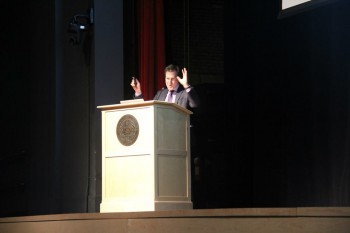by Ruth Leifer
As a social entrepreneurship student, I focus a large part of my studies on ways in which inequality can be reduced or absolved. So when Professor Stephen Nathanson began the Fourth Annual Boston Symposium on Economics by posing the question what is the opposite of income inequality, the answer seemed to be income equality. However, Dr. Nathanson dove into the literal meaning of income equality, pushing us to think about what exactly it entails. By outlining different ways to combat income inequality, such as equal opportunities within a society or the use of floors and ceilings on income levels, he illustrated that income equality is not an appropriate goal to strive for as it would ultimately create more harm than good. That being said, Dr. Nathanson spoke about the potential for limiting inequalities by creating a view of what constitutes a decent level of income. This income level would be set based on the needs for a specific society and would guarantee some sort of minimum for money and resources that could help to end poverty.
This concept of working towards limiting inequalities encouraged the audience to think outside of the obvious, but often not fully thought out, answers to inequality. With this mindset Dr. Jonathan Morduch took us through his current research, the U.S. Financial Diaries, which follows the financial data of over 200 low- and moderate-income households across the country. He found that most of the concerns of these households stemmed from an issue of illiquidity and the inequality of instability. Many of the households had members who had irregular work schedules, making it difficult to forecast the amount of money they would have at the end of each month. When they had a spike in income, they were often more likely to also have a spending spike during that same time period. However, there was still a 61% chance of a spending spike even without that income spike as some costs were difficult to predict, such as hospital bills or car repairs.
By combining Dr. Nathanson and Dr. Morduch’s approaches to inequality, we may have a basis for working towards eliminating the extreme levels of income inequality currently plaguing the United States. The first step may be to work towards creating a living wage floor that acts as the “decent level” of income Dr. Nathanson presented as a way to end poverty. Additionally, Dr. Morduch argued for a need for better job opportunities as well as new ways to enhance control and create resilience within these families. With this higher level of income paired with more stable jobs, those households that Dr. Morduch focused his research on may have the opportunity to begin solving their issues of illiquidity, especially if they are presented with the financial tools necessary to improve their savings and assist them in dealing with any financial emergencies that may arise.
With this deeper understanding of the needs of low- and middle-income families in America it is now time to create innovative ways to implement these steps.While the exact avenues to covert these ideas to realities may take time to correctly implement, the knowledge and research presented at the Economics Symposium has spurred the thoughts of many young minds to consider what can be done to solve the inequality issues currently plaguing the United States.




